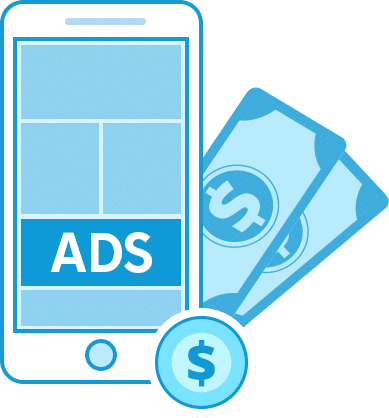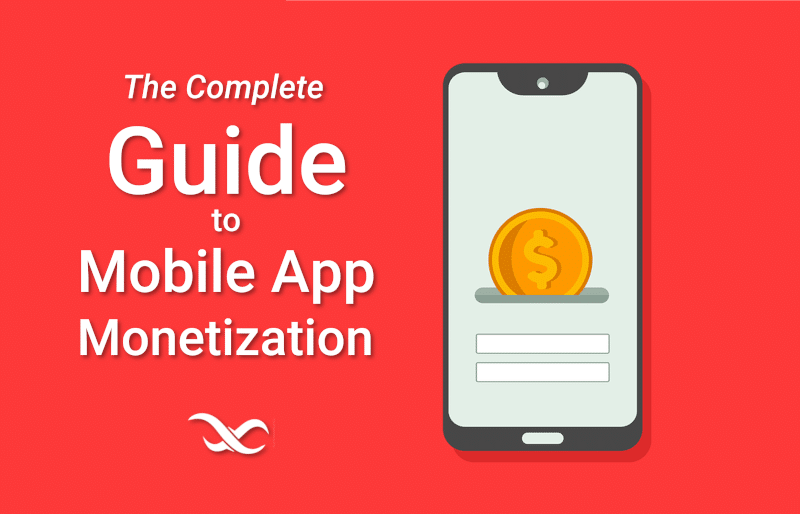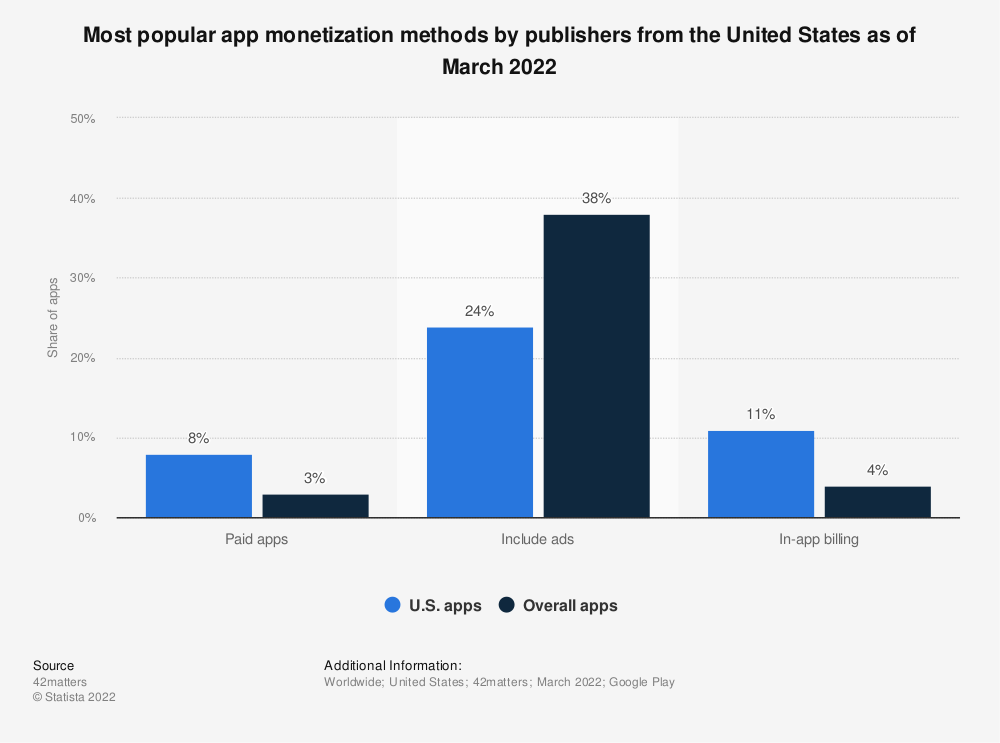Popular App Monetization Strategies
Apps are typically used to leverage the user base to earn revenue and are available in a range of forms of monetization including:
1. In-app Ads
2. Freemium Upgrades
3. Paid App Downloads
4. Sponsorships and Partnerships
5. Premium Subscriptions
6. In-App Purchases
7. Location-Based Services
8. User Data Mining
9. Physical Goods and Services
10. Crowdfunding
Before we dive into the details of these app revenue strategies, let’s discuss some important aspects to ensuring that your monetization strategy doesn’t inadvertently hamstring your app.
First, Do No Harm
Users understand that there’s a cost to every app. Even a free app is being “paid for” in some way, such as in-app advertising or selling user data. As the adage goes,
If something is free, you’re the product
That said, if your app monetization model has a major impact on the user experience, then you’re not going to make the most revenue you can.
For example, if you have an app that requires users to watch video ads every time they take a certain action, you are effectively disincentivizing that action. If that action doesn’t deliver significant value, then many users will give up and walk away.
Similarly, if you require users to pay for a feature of your app, then you are again disincentivizing the use of that feature. You either need to find ways to incentivize paying for that feature, or else you will chase away users that sought to use the feature.
Your chosen method for monetizing your app should be minimally disruptive to the user experience. If it’s not, it might be time to go back to the drawing board.
Understand the Core of Your App
What are the primary things your app offers? What brings in the user that very first time? What keeps them coming back?
In many cases, you may need to create an MVP – minimum viable product – to test your app on users and gather behavior data in order to answers these questions.
Once you understand what your users find most important, then you can start to find opportunities for monetization.
Make It Worth It
All app monetization models have their own drawbacks. The monetization method you choose will determine what steps should be taken to make it seem worth it to the user.
For example, if video ads are your best course of monetization, then make the reward for sitting through them worth it to the user.
If your app has features behind a pay wall, give users ample reason to break out their credit card.
If you want to charge for users to download your app, then make it an indispensable part of their day, or have your app be an invaluable complement to a larger ecosystem.

Top 10 App Monetization Strategies Explained
Let’s take a closer look at each of the aforementioned app monetization strategies, including breaking down the pros and cons of each.
1. In-app Ads
In-app ads are one of the most common forms of app monetization. They’re also one of the easiest to set up, which is why they’re so popular with app developers. Basically, you embed ads into your app content and then get paid every time someone clicks on an ad. The most common type of in-app ad is the banner ad, which is a small rectangular ad that appears at the top or bottom of the screen.
Banner ads can be effective if they’re well-designed and placed in strategic locations. But they can also be annoying and intrusive, which can lead to users uninstalling your app. If you do decide to go with banner ads, make sure you test different placements and designs to find what works best for your app and your users.
2. Freemium Upgrades
The freemium model is one of the most popular ways to monetize an app. Basically, you offer a basic version of your app for free, and then charge users for premium features or upgrades. This can be a great way to get users hooked on your app and then make money off of them later. It’s also a good way to get users to try out your app before they commit to paying for it.
However, the freemium model can be tricky to pull off. If you don’t offer enough value in the free version of your app, users will simply move on and never come back. And if you don’t upsell users effectively, you won’t make much money from the premium features. You need to strike a balance between offering enough value to keep users hooked and providing enough incentive for them to upgrade to the paid version.
3. Paid App Downloads
Paid app downloads are another monetization strategy. Basically, you charge users a one-time fee to download and use your app. This is a great way to monetize an app if you have a loyal following or if your app is high quality and provides a lot of value.
The downside of paid apps is that they can be difficult to market effectively. You need to convince users that your app is worth the price, which can be a challenge. According to Statista, the average price for an app on the Apple App Store is $0.80, meaning consumers are not expecting to spend much, if anything, on the apps they download.
Additionally, once someone pays to download the app, they’re less likely to upgrade to a premium version or make in-app purchases. So you need to make sure your app is worth the price tag from the start.
4. Sponsorships and Partnerships
Sponsorships and partnerships are another way to monetize an app. Basically, you find a company that’s willing to pay you to promote their product or service within your app. This can be a great way to monetize an app if you have a large and engaged user base.
The downside of sponsorships and partnerships is that they can be difficult to find. And, once you do find a sponsor, you’re usually locked into a contract for a certain period of time. So it’s important to make sure you find a sponsor that’s a good fit for your app and your users.
5. Premium Subscriptions
Premium subscriptions are another popular monetization strategy. Basically, you offer a basic version of your app for free, and then charge users for premium content or access. This can be a great way to monetize an app if you have a lot of valuable content.
The difference between Premium Subscriptions and the Freemium model is that Premium Subscriptions typically refer to content, such as videos, articles, etc., while Freemium tends to refer to features or upgrades (such as resources or levels in mobile games).
The challenge with Premium Subscriptions is that you need to strike that balance between offering enough engaging content for free and putting appealing content behind the paywall. If users don’t see enough value in your free content, they will leave and never come back. If they don’t see the value in the paid content, they won’t bother subscribing and you won’t make any revenue.
6. In-App Purchases
In-app purchases are a great way to monetize an app if you have a lot of valuable content or features. Basically, you offer users the ability to buy virtual goods or services within your app. This can be a great way to make money off of users who are already using and engaged with your app.
The downside of in-app purchases is that they can be difficult to market effectively. You need to convince users that the content or features you’re offering are worth the price, which can be a challenge. Once a user has paid for something in an app, their loyalty to that app is likely to be much greater. So give them a reason to make that first purchase!
7. Location-Based Services
Location-based services are another way to monetize an app. Basically, you charge users for access to content or features that are based on their location. This can be a great way to monetize an app if you have a lot of valuable localized content or features.
The downside of location-based services is that they require you to have content for as many areas that your app services as possible. These services can be a challenge to scale, and may require paying users themselves to create the content for you.
8. User Data Mining
User data mining is another way to monetize an app. Basically, you collect data about your users and then sell it to third-party companies. This can be a great way to monetize an app if you have a lot of valuable user data.
The downside of user data mining is that it can be difficult to do effectively. You need to make sure you’re collecting the right data and that you’re doing it in a way that’s compliant with privacy laws. Additionally, users may be less likely to trust your app if they know you’re selling their data.
9. Physical Goods and Services
Selling physical goods and services is another way to monetize your app. Basically, you sell physical goods or services through your app. This can be a great way to monetize an app if you have loyal users that enjoy sharing your brand or content.
The downside of physical goods and services is that they may require you to have a lot of inventory on hand, or find a vendor to handle production on demand. Managing the logistics of selling physical goods adds a significant layer of complexity to operating your app. On the other hand, some physical goods – such as branded shirts, hats, stickers, etc. – can be a great way of turning your users into marketers!
10. Crowdfunding
Crowdfunding is another way to monetize your mobile app. Basically, you offer users the ability to donate money to support your app. This can be a great way to monetize an app if you have a loyal following that believes in your mission.
The downside of crowdfunding is that it requires you to have a large and engaged user base. If you don’t have a lot of users, or if your users aren’t particularly engaged, it will be difficult to raise money through crowdfunding. Additionally, you may need to offer rewards or perks to users who donate, which can add to the cost of running your app.
Why is app monetization important?
App monetization is important because it allows you to generate revenue from your app. Without app monetization, you would need to rely on other sources of income to support your app development efforts. Additionally, app monetization provides resources to help you acquire new users and keep existing users engaged with your app.
What impact do app store policies have on app monetization?
When choosing your app monetization strategy, it’s important to understand that few monetization strategies deliver 100% of the revenue generated directly to you. In most cases, if your monetization strategy involves direct user payments for digital goods or services – subscriptions, pay-to-download, freemium upgrades, etc. – you can expect as much as 30% of those fees to go to the app stores.
You can avoid these fees by deploying your app as a web-based application. For example, you can build your app to be structured for mobile (or responsive for mobile, tablet and desktop screen sizes) and allow users to access it through their browser. There are both pros and cons to this approach, but monetization is something that must be considered.
In addition to the fees, there are other rules that the Apple App Store and Google Play Store enforce that may impact your monetization strategy. Certain forms of monetization are not allowed at all (for example, fees taken to facilitate certain types of wagering).
The app stores also do not take kindly to attempts to circumvent their fees. For example, if you offer a premium subscription that must be bought through your website rather than in-app, you may face pushback from Apple and Google.

How does mobile advertising work?
Mobile advertising is a form of app monetization where you sell ad space in your app. Advertisers will pay you to display their ads in your app, and you will share a portion of that revenue with the app store.
The downside of mobile advertising is that it can be intrusive and interrupt the user experience. Additionally, users may be less likely to use your app if they are bombarded with ads.
Native Ads
Native ads are a type of mobile advertising that is less intrusive than other forms. Native ads are designed to blend in with the content of your app, and they often take the form of sponsored content or product recommendations.
The upside of native advertising is that it can be more expensive than other forms of mobile advertising. This can also be a downside, as it means it can be more difficult to secure advertisers. Additionally, users may still find native ads to be intrusive, particularly if they are not relevant to the content of your app.
Ad Networks
Ad networks are companies that connect advertisers with app publishers. Ad networks will typically take a cut of the ad revenue, meaning you will receive less money for displaying ads in your app.
The upside of using an ad network is that they can help you find advertisers. The downside is that you will likely earn less money per ad, and you may have less control over the ads that are displayed in your app.
Mobile advertising may pay out on a pay-per-click (PPC)/cost-per-click (CPC) or pay-per-impression (PPM)/cost-per-impression (CPM) basis. Payments are generally very small, so it may require a significant amount of user traffic in your app to generate meaningful revenue with this model.
What are some common mobile ad formats?
Ad format can have a noticeable impact on your app’s user experience. Picking the right ad format is very important for ensuring users aren’t turned off from your app.
Banner Ads
Banner ads are the most common type of mobile ad. They are typically small rectangular ads that appear at the top or bottom of the screen.
Banner ads can be effective, but they are also the most intrusive type of mobile ad. As a result, they can have a negative impact on user experience.
Interstitial Ads
Interstitial ads are full-screen ads that appear between app content. They can be effective, but they are also very intrusive.
Video Ads
Video ads are becoming more common as mobile devices become more powerful. Video ads can be effective, but they require a significant amount of bandwidth and can have a negative impact on user experience.
Rewarded Video Ads
Rewarded video ads are a type of video ad that allows users to watch an ad in exchange for a reward. This reward can be in-app currency, access to premium content, or other perks.
Rewarded video ads are less intrusive than other forms of video ad, and they can be more effective because users are voluntarily watching the ad.
Closing thoughts
There is no one-size-fits-all answer to the question of how to monetize your mobile app. The best monetization strategy for your app will depend on a number of factors, including the type of app, the audience, and the platform you are using.
When choosing a monetization strategy, it is important to consider the impact on user experience. Intrusive ads can lead to users abandoning your app, so it is important to strike a balance between generating revenue and providing a positive user experience.
Additionally, it is important to consider the platform you are using. Apple and Google have different policies regarding app monetization, so be sure to research the guidelines before you start implementing a monetization strategy.
Finally, remember that there is no single perfect solution for app monetization. The best approach is to experiment with different strategies and find the one that works best for your app and your audience.
Frequently Asked Questions
How does a free app make money?
There are a number of ways to monetize free to download apps. The most common is through mobile advertising. Other app monetization methods include in-app purchases, premium subscriptions, and sponsorship.
How do you monetize a free app without ads?
There are a number of ways to monetize free apps without ads. The most common approach to free app monetization is through in-app purchases, but other revenue generation options include premium subscription models and sponsorship.
What percentage of mobile apps are successful?
There is no definitive answer to this question. However, a recent study found that only about 1% of mobile app developers earn more than $5,000 per month from their apps.
How can I improve my app’s monetization?
There are a number of things you can do to improve your app’s monetization. These include making sure your app is well-designed and user-friendly, offering valuable content or features, and targeting a specific niche market.
What are some common mistakes with app monetization?
Some common mistakes with app monetization include placing too many ads in your app, not offering enough value to users, and not properly targeting your audience.
Is there a difference between iOS App Store monetization and Android Play Store monetization?
iOS app monetization strategies and Android app monetization strategies are generally the same. The main difference will come with the app store terms of service.
You will want to ensure that your monetization strategy works the same for both platforms according to their terms. If it doesn’t you may need to reconsider your strategy, or focus your marketing and promotional efforts on the platform that benefits you most.



